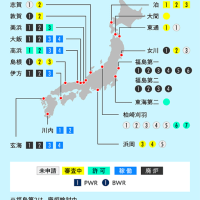" Though it is story of state of nuclear fuel rod"
The first machine is assumed to have damaged about 30 percent and the third machines to 70 percent and the second machines by about 25 percent as Tokyo Electric Power Company made it public.
This is called a cladding tube with which the part that is called the pellet of the fuel rod is covered.
It is shown for what can be done with zirconium alloys to melt, and to have damaged the pellet.
Hydrogen is generated reacting with water, and the nuclear fuel expands, it arrives at 2800 degrees, and the zirconium in this cladding tube melts when it begins to melt by 1800 degrees, and it becomes a high temperature in addition when it becomes 1200 degrees. This is meltdown.
It doesn't occur, and the explosion explodes easily also if it is a little spark if there are a in any way or nor houses where the fire started though the explosion occurred in the hydrogen that leaks from the nuclear reactor and containment in 1 and 2-the third machine though it returns to speaking hydrogen.
I think that part has melted to the pellet. And, it was full meltdown in the first machine by which the molten state of this pellet grasped the scenario in the future three days ago.
It is assumed that it stands in the fuel rod bulrush. Is it thud suddenly l which it is under of what when falling?Water in the bottom of the pressure vessel is rapidly heated, it makes momentarily, it evaporates, and the steam explosion is caused.
Even if it happens in which nuclear reactor at what time when, this steam explosion is really happen.
The pressure vessel in part heart 'in a strong nuclear reactor that consists of a stainless double layer system is first destroyed, and there is a possibility of easily blowing off even containment 《 the structure to cover the steel of three centimeters in thickness with the concrete of two meters in thickness) that exists in addition on the outside in the impact, too with the steel of 16 centimeters in thickness when this steam explosion is generated.
Koide Hiroaki : Kyoto University nuclear reactor experiment office assistant professor. Nucleonics.
「核燃料棒の状態のお話しですが、」
東京電力が公表したように、1号機は70パーセント、2号機は約30パーセント、3号機は約25パーセント、損傷しているとされています。
これは、燃料棒のペレットと呼ばれる部分を覆う被覆管と言う
ジルコニウム合金で出来たものが溶け、ペレット自体が損傷していることを表している。
この被覆管のジルコニウムは、1200度になると水と反応して水素を発生させ、1800度で溶融し始め、さらに高温になると核燃料そのものが膨張し、2800度に至って溶融する。これがメルトダウンだ。
水素の話しに戻りますが、1、2、3号機では、原子炉や格納容器から漏れた水素で爆発が起きましたが、何らかに火元がないと爆発は起きません、しかし、ちょっとした火花でもあれば、簡単に爆発してしまいます。
私は、ペレットに一部が溶融しているとおもいます。そして、このペレットの溶融状態が今後のシナリオを握っています1号機では3日前でフルメルトダウンでした。
燃料棒がまだ立っているとする。それがいきなりドサっと落ちたら、どういうことがおきるlか。圧力容器の底にある水が急激に熱せられ、一瞬にして蒸発して水蒸気爆発を起こしてしまうのです。
この水蒸気爆発はどの原子炉でいつ何時起こってもおかしくありません
この水蒸気爆発が発生すると、厚さ16センチの鋼鉄とステンレスの二層構造からなる頑丈な原子炉の心臓’部の圧力容器を先ず破壊し、さらにその衝撃で、その外側にある格納容器《厚さ3センチの鋼鉄を厚さ2メーターのコンクリートで覆う構造)さえも簡単に吹き飛ばしてしまう可能性があるのです。
小出裕章 京都大学原子炉実験所助教授。 原子核工学。



















